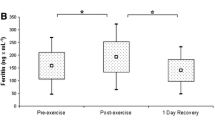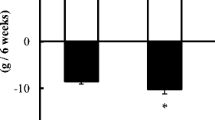Abstract
Currently, it is unclear which index of haematological parameters could be used to most easily monitor iron deficiency during endurance training. To address this question, 16 male Wistar rats were randomly assigned to two groups: a sedentary group (n = 8) and an exercised group (n = 8). Initially, animals in the exercise group started running on a treadmill at a rate of 30 m/min, on a 0% grade, for 1 min/session. Running time was gradually increased by 2 min/day. The training plan was one session per day during the initial 2 weeks and two sessions per day during the third to ninth week. At the end of the 9-week experiment, we analysed the blood of the experimental animals for haemoglobin levels, erythrocyte numbers, haematocrit, serum iron levels, total iron binding capacity, transferrin saturation, serum ferritin levels and soluble transferrin receptor (sTfR) levels, and we calculated the ratio of sTfR/ferritin. Erythrocyte numbers, haemoglobin levels and haematocrit values were decreased after 9 weeks of exercise, but sTfR and sTfR/ferritin values were increased (P < 0.01 or P < 0.05). The training regime significantly increased TfR mRNA levels in the bone marrow cells of the exercised rats compared with the sedentary group (1.8 ± 0.5 vs. 1.1 ± 0.2, P < 0.01). These results revealed a significant correlation between TfR levels in the bone marrow cells and the ratio of sTfR/ferritin (r = 0.517; P < 0.01) and sTfR levels (r = 0.206; P < 0.05) in sedentary and exercised rats. In conclusion, we show that sTfR indices and the ratio of sTfR/ferritin could be useful indicators for monitoring iron deficiency during endurance training.

Similar content being viewed by others
References
Peeling P (2010) Exercise as a mediator of hepcidin activity in athletes. Eur J Appl Physiol 110(5):877–883
Clarkson PM, Haymes EM (1995) Exercise and mineral status of athletes: calcium, magnesium, phosphorus, and iron. Med Sci Sports Exerc 27(6):831–843
Qian ZM, Xiao DS, Tang PL, Yao FY, Liao QK (1999) Increased expression of transferrin receptor on membrane of erythroblasts in strenuously exercised rats. J Appl Physiol 87(2):523–529
Newhouse IJ, Clement DB (1988) Iron status in athletes. An update Sports Med 5(6):337–352
Naziroglu M, Simsek M, Kutlu M (2004) Moderate exercise with a dietary vitamin C and E combination protects against streptozotocin-induced oxidative damage to the blood and improves fetal outcomes in pregnant rats. Clin Chem Lab Med 42(5):511–517
Naziroglu M, Butterworth PJ (2005) Protective effects of moderate exercise with dietary vitamin C and E on blood antioxidative defense mechanism in rats with streptozotocin-induced diabetes. Can J Appl Physiol 30(2):172–185
Di Santolo M, Stel G, Banfi G, Gonano F, Cauci S (2008) Anemia and iron status in young fertile non-professional female athletes. Eur J Appl Physiol 102(6):703–709
Deruisseau KC, Roberts LM, Kushnick MR, Evans AM, Austin K, Haymes EM (2004) Iron status of young males and females performing weight-training exercise. Med Sci Sports Exerc 36(2):241–248
Beard J, Tobin B (2000) Iron status and exercise. Am J Clin Nutr 72(2 Suppl):594S–597S
Malczewska J, Szczepanska B, Stupnicki R, Sendecki W (2001) The assessment of frequency of iron deficiency in athletes from the transferrin receptor-ferritin index. Int J Sport Nutr Exerc Metab 11(1):42–52
Thurnham DI, McCabe LD, Haldar S, Wieringa FT, Northrop-Clewes CA, McCabe GP (2010) Adjusting plasma ferritin concentrations to remove the effects of subclinical inflammation in the assessment of iron deficiency: a meta-analysis. Am J Clin Nutr 92(3):546–555
Phiri KS, Calis JC, Kachala D, Borgstein E, Waluza J, Bates I, Brabin B, van Hensbroek MB (2009) Improved method for assessing iron stores in the bone marrow. J Clin Pathol 62(8):685–689
Mullner EW, Neupert B, Kuhn LC (1989) A specific mRNA binding factor regulates the iron-dependent stability of cytoplasmic transferrin receptor mRNA. Cell 58(2):373–382
Iacopetta BJ, Morgan EH, Yeoh GC (1982) Transferrin receptors and iron uptake during erythroid cell development. Biochim Biophys Acta 687(2):204–210
Skikne BS (2008) Serum transferrin receptor. Am J Hematol 83(11):872–875
Berlin T, Meyer A, Rotman-Pikielny P, Natur A, Levy Y (2011) Soluble transferrin receptor as a diagnostic laboratory test for detection of iron deficiency anemia in acute illness of hospitalized patients. Isr Med Assoc J 13(2):96–98
Munoz M, Garcia-Erce JA, Remacha AF (2011) Disorders of iron metabolism. Part 1: molecular basis of iron homoeostasis. J Clin Pathol 64(4):281–286
Goodnough LT, Skikne B, Brugnara C (2000) Erythropoietin, iron, and erythropoiesis. Blood 96(3):823–833
Jain S, Narayan S, Chandra J, Sharma S, Malhan P (2010) Evaluation of serum transferrin receptor and sTfR ferritin indices in diagnosing and differentiating iron deficiency anemia from anemia of chronic disease. Indian J Pediatr 77(2):179–183
Sazawal S, Black RE, Ramsan M, Chwaya HM, Stoltzfus RJ, Dutta A, Dhingra U, Kabole I, Deb S, Othman MK, Kabole FM (2006) Effects of routine prophylactic supplementation with iron and folic acid on admission to hospital and mortality in preschool children in a high malaria transmission setting: community-based, randomised, placebo-controlled trial. Lancet 367(9505):133–143
Zhao J, Tian Y, Xu J, Liu D, Wang X, Zhao B (2011) Endurance exercise is a leptin signaling mimetic in hypothalamus of Wistar rats. Lipids Health Dis 10(1):225
Ohsako M, To H, Nakamura C, Yamada M, Tsuzuki O, Tatsuo E, Nakashima T, Hirai M, Sasaki H, Ichikawa M, Matsuya F, Saito Y (1998) Change in erythrocyte shape induced by cyclosporine administration. Biol Pharm Bull 21(11):1236–1239
Yang HY, Jeong DK, Kim SH, Chung KJ, Cho EJ, Jin CH, Yang U, Lee SR, Lee DS, Lee TH (2008) Gene expression profiling related to the enhanced erythropoiesis in mouse bone marrow cells. J Cell Biochem 104(1):295–303
Chomczynski P, Sacchi N (1987) Single-step method of RNA isolation by acid guanidinium thiocyanate-phenol-chloroform extraction. Anal Biochem 162(1):156–159
Yamaguchi M, Yamauchi A, Nishimura M, Ueda N, Naito S (2005) Soybean oil fat emulsion prevents cytochrome P450 mRNA down-regulation induced by fat-free overdose total parenteral nutrition in infant rats. Biol Pharm Bull 28(1):143–147
Nishimura M, Ueda N, Naito S (2003) Effects of dimethyl sulfoxide on the gene induction of cytochrome P450 isoforms, UGT-dependent glucuronosyl transferase isoforms, and ABCB1 in primary culture of human hepatocytes. Biol Pharm Bull 26(7):1052–1056
Nishimura M, Imai T, Morioka Y, Kuribayashi S, Kamataki T, Naito S (2004) Effects of NO-1886 (Ibrolipim), a lipoprotein lipase-promoting agent, on gene induction of cytochrome P450s, carboxylesterases, and sulfotransferases in primary cultures of human hepatocytes. Drug Metab Pharmacokinet 19(6):422–429
Zhao JX, Tian Y, Cao JMLJ (2004) Effect of different exercise on hemoglobin levels in rats—an animal model of sports anemia. Ch J Sports Med (China) 23(4):436–440
Broadbent S (2011) Seasonal changes in haematology, lymphocyte transferrin receptors and intracellular iron in Ironman triathletes and untrained men. Eur J Appl Physiol 111(1):93–100
Cappelli K, Felicetti M, Capomaccio S, Spinsanti G, Silvestrelli M, Supplizi AV (2008) Exercise induced stress in horses: selection of the most stable reference genes for quantitative RT-PCR normalization. BMC Mol Biol 9:49
Li YQ, Yan H, Bai B (2008) Change in iron transporter expression in human term placenta with different maternal iron status. Eur J Obstet Gynecol Reprod Biol 140(1):48–54
Che LL, Xiao DS, Xu HX, Lu L (2011) Changes of iron stores and duodenal transepithelial iron transfer during regular exercise in rats. Biol Trace Elem Res 143(2):1044–1053
Frank MK, Esteves AM, Lopes C, Cavagnolli DA, Tufik S, de Mello MT (2011) The effects of physical exercise on the serum iron profile in spontaneously hypertensive rats. Biol Trace Elem Res. doi:10.1007/s12011-011-9188-5
Nikolaidis MG, Michailidis Y, Mougios V (2003) Variation of soluble transferrin receptor and ferritin concentrations in human serum during recovery from exercise. Eur J Appl Physiol 89(5):500–502
Abellan R, Ventura R, Pichini S, Palmi I, Bellver M, Olive R, Pacifici R, Pascual JA, Zuccaro P, Segura J (2007) Effect of physical fitness and endurance exercise on indirect biomarkers of recombinant erythropoietin misuse. Int J Sports Med 28(1):9–15
Nielsen OJ, Andersen LS, Hansen NE, Hansen TM (1994) Serum transferrin receptor levels in anaemic patients with rheumatoid arthritis. Scand J Clin Lab Invest 54(1):75–82
Karlsson T, Sjoo F, Kedinge-Cyrus B, Backstrom B (2010) Plasma soluble transferrin receptor assay when screening for iron-deficiency in an unselected population of elderly anaemic patients. J Intern Med 267(3):331–334
Acknowledgements
This work was supported by The National Natural Science Foundation of China (30270642) and the Foundation of China Society of Sport Science (2005-04). The authors thank Xiaofang Wang, Kimberly A. Hubing, Yongsheng Zhu and James Pearson for their assistance in editing with respect to English style. The authors also wish to thank The Genomics and Bioinformatics Center Chinese Academy of Science for the technical assistance.
Author information
Authors and Affiliations
Corresponding author
Additional information
Jiexiu Zhao and Ye Tian contributed equally to this work.
Rights and permissions
About this article
Cite this article
Tian, Y., Zhao, J., Zhao, B. et al. The Ratio of sTfR/Ferritin is Associated with the Expression Level of TfR in Rat Bone Marrow Cells After Endurance Exercise. Biol Trace Elem Res 147, 261–266 (2012). https://doi.org/10.1007/s12011-011-9312-6
Received:
Accepted:
Published:
Issue Date:
DOI: https://doi.org/10.1007/s12011-011-9312-6




